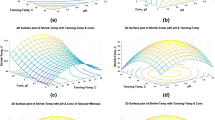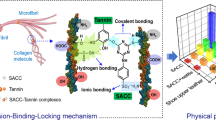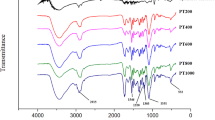Abstract
Increased concern over the use of metal salts such as chromium, zirconium, and aluminum for tanning of hides and skins has made the leather production industry to be constantly on the lookout for organic tanning agents in place of the inorganic system. Though glutaraldehyde has been looked at as a viable option, it still lags in imparting superior strength properties to the leather and also it has been reported to have inherent toxicity. With that concept in view, this research work focuses on the usage of glyoxal along with synthetic tanning agents as a replacement for glutaraldehyde and other inorganic tanning systems. The offer level and starting pH for the glyoxal tanning process was optimized as 6% (w/w) and 5.0, respectively, and the shrinkage temperature of the collagen was found to be around 80 °C. Additionally, the controlled shrunken grain effect of the aldehyde tanning system was explored by changing the pH of the process, which helped to improve the thickness of low-grade thinner raw materials by up to 40%. The mechanism for the shrunken grain effect has also been proposed in this work by studying the dimensional changes occurring in the leather matrix upon treating skin/hide with glyoxal at different pH levels. The mechanical and strength properties of the leather were found to be better than the glutaraldehyde tanning system. The BOD/COD ratio of wastewater generated from the glyoxal process was found to be greater than 0.3 making them easily treatable. Considering all these factors, compact glyoxal-based tanning along with synthetic tanning agents can be a game-changing technology for the leather processing industry.
Graphical abstract







Similar content being viewed by others
Availability of data and materials
Not applicable.
References
Arellano-Sánchez MG, Devouge-Boyer C, Hubert-Roux M et al (2021) Chromium determination in leather and other matrices: a review. Crit Rev Anal Chem 0:1–20. https://doi.org/10.1080/10408347.2021.1890545
Beghetto V, Agostinis L, Gatto V et al (2019) Sustainable use of 4-(4,6-dimethoxy-1,3,5-triazin-2-yl)-4-methylmorpholinium chloride as metal free tanning agent. J Clean Prod 220:864–872. https://doi.org/10.1016/j.jclepro.2019.02.034
Camacho NP, West P, Torzilli PA, Mendelsohn R (2001) FTIR microscopic imaging of collagen and proteoglycan in bovine cartilage. Biopolymers 62:1–8. https://doi.org/10.1002/1097-0282(2001)62:1%3c1::AID-BIP10%3e3.0.CO;2-O
China CR, Maguta MM, Nyandoro SS et al (2020) Alternative tanning technologies and their suitability in curbing environmental pollution from the leather industry: a comprehensive review. Chemosphere 254:126804. https://doi.org/10.1016/j.chemosphere.2020.126804
Christen V, Faltermann S, Brun NR et al (2017) Cytotoxicity and molecular effects of biocidal disinfectants (quaternary ammonia, glutaraldehyde, poly(hexamethylene biguanide) hydrochloride PHMB) and their mixtures in vitro and in zebrafish eleuthero-embryos. Sci Total Environ 586:1204–1218. https://doi.org/10.1016/j.scitotenv.2017.02.114
Covington AD (1997) Modern tanning chemistry. Chem Soc Rev 26:111–126. https://doi.org/10.1039/CS9972600111
de Campos VB, Mello MLS (2011) Collagen type I amide I band infrared spectroscopy. Micron 42:283–289. https://doi.org/10.1016/j.micron.2010.09.010
Ding W, Pang X, Ding Z et al (2020) Constructing a robust chrome-free leather tanned by biomass-derived polyaldehyde via crosslinking with chitosan derivatives. J Hazard Mater 396:122771. https://doi.org/10.1016/j.jhazmat.2020.122771
ECHA (2021) Glutaraldehyde information — ECHA. https://echa.europa.eu/substance-information/-/substanceinfo/100.003.506. Accessed 8 Oct 2021
Esteban B, Baquero G, Cuadros R, Morera JM (2021) Proposal and application of a new method to determine leather shrinkage temperature. Thermochim Acta 698:178880. https://doi.org/10.1016/j.tca.2021.178880
Fan QG, Lewis DM, Tapley KN (2001) Characterization of cellulose aldehyde using Fourier transform infrared spectroscopy. J Appl Polym Sci 82:1195–1202. https://doi.org/10.1002/app.1953
Fathima NN, Dhathathreyan A, Ramasami T (2002) Mercury intrusion porosimetry, nitrogen adsorption, and scanning electron microscopy analysis of pores in skin. Biomacromol 3:899–904. https://doi.org/10.1021/bm025541q
Gowthaman K, Vikram S, Fathima NN, Rao JR (2012) Quality enhancement of low grade wet blue leathers: up-grading of thin substance in wet end process. J Am Leather Chem Assoc 107:292–301
Hansen É, Monteiro de Aquim P, Hansen AW et al (2020) Impact of post-tanning chemicals on the pollution load of tannery wastewater. J Environ Manage 269:110787. https://doi.org/10.1016/j.jenvman.2020.110787
Hansen É, de Aquim PM, Gutterres M (2021) Environmental assessment of water, chemicals and effluents in leather post-tanning process: a review. Environ Impact Assess Rev 89:106597. https://doi.org/10.1016/j.eiar.2021.106597
He X, Wang Y, Zhou J, et al. (2019) Suitability of pore measurement methods for characterizing the hierarchical pore structure of leather. Journal of the American Leather Chemists Association 114:
Hedberg YS (2020) Chromium and leather: a review on the chemistry of relevance for allergic contact dermatitis to chromium. J Leather Sci Eng 2:20. https://doi.org/10.1186/s42825-020-00027-y
Hu Y, Liu J, Luo L et al (2020) Kinetics and mechanism of thermal degradation of aldehyde tanned leather. Thermochim Acta 691:178717. https://doi.org/10.1016/j.tca.2020.178717
International Leather Maker (2021) EU Commission plans to class glutaraldehyde as a substance of very high concern - International Leather Maker. https://internationalleathermaker.com/news/fullstory.php/aid/9640/EU_Commission_plans_to_class_glutaraldehyde_as_a_substance_of_very_high_concern.html. Accessed 8 Oct 2021
Jiang Z, Ding W, Xu S et al (2020) A ‘Trojan horse strategy’ for the development of a renewable leather tanning agent produced via an AlCl3-catalyzed cellulose depolymerization. Green Chem 22:316–321. https://doi.org/10.1039/C9GC03538A
Jiang Z, Gao M, Remón J et al (2021a) On the development of chrome-free tanning agents: an advanced Trojan horse strategy using ‘Al–Zr-oligosaccharides’ produced by the depolymerization and oxidation of biomass. Green Chem 23:2640–2651. https://doi.org/10.1039/D0GC04155F
Jiang Z, Xu S, Ding W et al (2021b) Advanced masking agent for leather tanning from stepwise degradation and oxidation of cellulose. Green Chem 23:4044–4050. https://doi.org/10.1039/D1GC01264A
Kim U-J, Lee YR, Kang TH et al (2017) Protein adsorption of dialdehyde cellulose-crosslinked chitosan with high amino group contents. Carbohyd Polym 163:34–42. https://doi.org/10.1016/j.carbpol.2017.01.052
Krishnamoorthy G, Sadulla S, Sehgal PK, Mandal AB (2012) Green chemistry approaches to leather tanning process for making chrome-free leather by unnatural amino acids. J Hazard Mater 215–216:173–182. https://doi.org/10.1016/j.jhazmat.2012.02.046
Lewis RJ (1996) Sax’s dangerous properties of industrial materials, 9th edn. Van Nostrand Reinhold, New York
Lewis RJ (2004) Sax’s dangerous properties of industrial materials, 11th edn. Wiley & Sons, Hoboken, N.J.
Liang-qiong P, Wen-jun L, Wen-hua Z, Bi S (2020) Chromium leachability from leather waste and eco-toxicity under environmental conditions. J Am Leather Chem Assoc 115:87–95
Liu X, Yue O, Wang X et al (2020) Preparation and application of a novel biomass-based amphoteric retanning agent with the function of reducing free formaldehyde in leather. J Clean Prod 265:121796. https://doi.org/10.1016/j.jclepro.2020.121796
Mehta A, Rao JR, Fathima NN (2014) Effect of ionic liquids on the different hierarchical order of type I collagen. Colloids Surf, B 117:376–382. https://doi.org/10.1016/j.colsurfb.2014.03.014
Merkel R, Liu C-K, Latona N et al (2013) Effects of level ad length of supplementation on leather characteristics of yearling Boer and Spanish wethers. J Am Leather Chem Assoc 108:139–145
O’flaherty F, Roddy WT, Lollar RM (1965) The chemistry and technology of leather. Vol. IV. Evaluation of leather.
Qiang T, Gao X, Ren J et al (2016) A chrome-free and chrome-less tanning system based on the hyperbranched polymer. ACS Sustainable Chem Eng 4:701–707. https://doi.org/10.1021/acssuschemeng.5b00917
Ramesh RR, Muralidharan V, Palanivel S (2018) Preparation and application of unhairing enzyme using solid wastes from the leather industry—an attempt toward internalization of solid wastes within the leather industry. Environ Sci Pollut Res 25:2121–2136. https://doi.org/10.1007/s11356-017-0550-9
Sathish M, Bhuvansewari TS, Rao J, Fathima N (2017) Effect of syntan to fatliquor ration on porosity and mechanical properties of wet-blue leather. J Am Leather Chem Assoc 112:121–127
Shi J, Wang C, Ngai T, Lin W (2018) Diffusion and binding of laponite clay nanoparticles into collagen fibers for the formation of leather matrix. Langmuir 34:7379–7385. https://doi.org/10.1021/acs.langmuir.8b00923
Shi J, Wang C, Hu L et al (2019) Novel wet-white tanning approach based on laponite clay nanoparticles for reduced formaldehyde release and improved physical performances. ACS Sustainable Chem Eng 7:1195–1201. https://doi.org/10.1021/acssuschemeng.8b04845
Shi J, Zhang R, Mi Z et al (2021) Engineering a sustainable chrome-free leather processing based on novel lightfast wet-white tanning system towards eco-leather manufacture. J Clean Prod 282:124504. https://doi.org/10.1016/j.jclepro.2020.124504
Singh A, Gundimeda H (2021) Impact of bad outputs and environmental regulation on efficiency of Indian leather firms: a directional distance function approach. J Environ Planning Manage 64:1331–1351. https://doi.org/10.1080/09640568.2020.1822307
Thanikaivelan P, Rao JR, Nair BU, Ramasami T (2004) Progress and recent trends in biotechnological methods for leather processing. Trends Biotechnol 22:181–188. https://doi.org/10.1016/j.tibtech.2004.02.008
Wang Y, Huang W, Zhang H et al (2017) Surface charge and isoelectric point of leather: a novel determination method and its application in leather making. J Am Leather Chem Assoc 112:224–231
Whipple EB (1970) Structure of glyoxal in water. J Am Chem Soc 92:7183–7186. https://doi.org/10.1021/ja00727a027
Wise CS, Mehltretter CL, Van Cleve JW (1959) Rapid colorimetric method for determining glyoxal. Anal Chem 31:1241–1242. https://doi.org/10.1021/ac60151a005
Wu X, Qiang X, Liu D et al (2020) An eco-friendly tanning process to wet-white leather based on amino acids. J Clean Prod 270:122399. https://doi.org/10.1016/j.jclepro.2020.122399
Yu L, Qiang X, Cui L et al (2020) Preparation of a syntan containing active chlorine groups for chrome-free tanned leather. J Clean Prod 270:122351. https://doi.org/10.1016/j.jclepro.2020.122351
Zhou Y, Ma J, Gao D et al (2018) A novel chrome-free tanning approach based on sulfonated tetraphenyl Calix[4]resorcinarene: preparation and application. J Clean Prod 201:668–677. https://doi.org/10.1016/j.jclepro.2018.07.196
Acknowledgements
The authors would like to thank Mr. V. Karthik, Regional Centre, CLRI, Jalandhar for the fruitful discussions about the industrial practices in leather production and for evaluating the organoleptic properties of the leathers made during the research work (CSIR-CLRI communication number: 1616).
Funding
The authors would like to thank Council of Scientific and Industrial Research (CSIR)-MLP11-RIEES (Research Initiatives for Ensuring Environmental and Economic Sustainability) for providing funds to carry out this research work.
Author information
Authors and Affiliations
Contributions
RRR designed the work, interpreted the results of experiments, and drafted the manuscript. MP carried out the leather tanning trials and wastewater analysis. AR and SR reviewed the results and revised the draft manuscript. All authors read and approved the final manuscript.
Corresponding author
Ethics declarations
Ethics approval and consent to participate
Not applicable.
Consent for publication
Not applicable.
Competing interests
The authors declare no competing interests.
Additional information
Responsible Editor: Philippe Garrigues
Publisher’s note
Springer Nature remains neutral with regard to jurisdictional claims in published maps and institutional affiliations.
Rights and permissions
About this article
Cite this article
Ramesh, R.R., Ponnuvel, M., Ramalingam, S. et al. Compact glyoxal tanning system: a chrome-free sustainable and green approach towards tanning-cum-upgradation of low-grade raw materials in leather processing. Environ Sci Pollut Res 29, 35382–35395 (2022). https://doi.org/10.1007/s11356-022-18660-x
Received:
Accepted:
Published:
Issue Date:
DOI: https://doi.org/10.1007/s11356-022-18660-x




